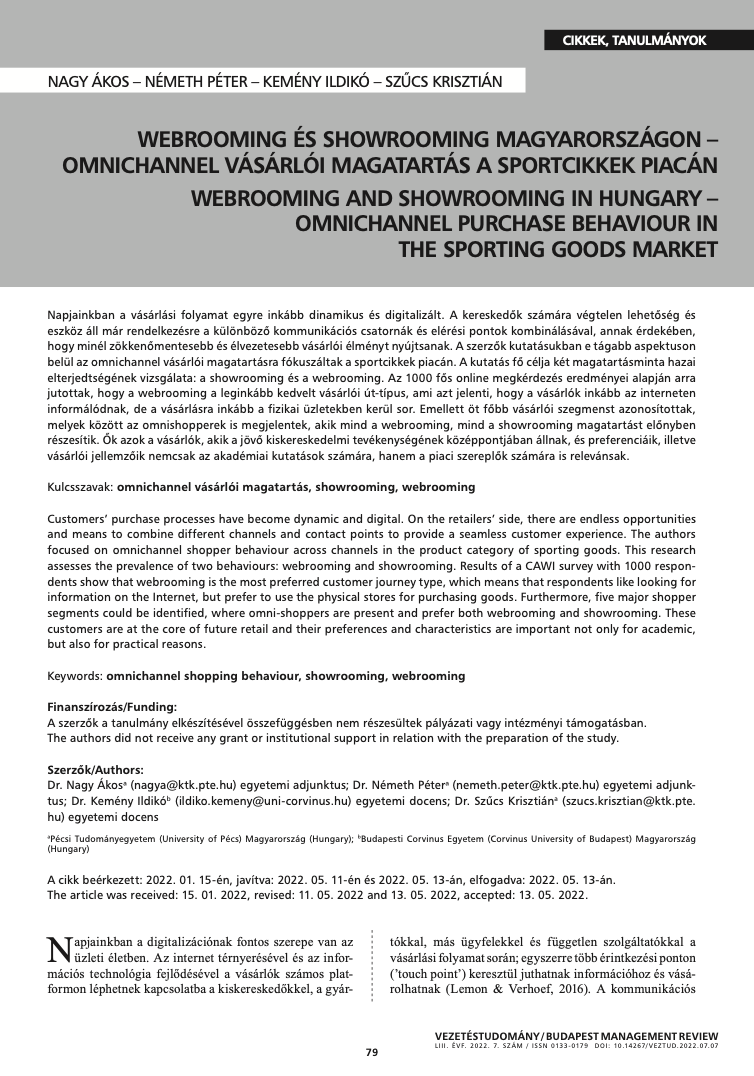Webrooming és showrooming Magyarországon
Omnichannel vásárlói magatartás a sportcikkek piacán
DOI:
https://doi.org/10.14267/VEZTUD.2022.07.07Kulcsszavak:
omnichannel vásárlói magatartás, showrooming, webroomingAbsztrakt
Napjainkban a vásárlási folyamat egyre inkább dinamikus és digitalizált. A kereskedők számára végtelen lehetőség és eszköz áll már rendelkezésre a különböző kommunikációs csatornák és elérési pontok kombinálásával, annak érdekében, hogy minél zökkenőmentesebb és élvezetesebb vásárlói élményt nyújtsanak. A szerzők kutatásukban e tágabb aspektuson belül az omnichannel vásárlói magatartásra fókuszáltak a sportcikkek piacán. A kutatás fő célja két magatartásminta hazai elterjedtségének vizsgálata: a showrooming és a webrooming. Az 1000 fős online megkérdezés eredményei alapján arra jutottak, hogy a webrooming a leginkább kedvelt vásárlói út-típus, ami azt jelenti, hogy a vásárlók inkább az interneten informálódnak, de a vásárlásra inkább a fizikai üzletekben kerül sor. Emellett öt főbb vásárlói szegmenst azonosítottak, melyek között az omnishopperek is megjelentek, akik mind a webrooming, mind a showrooming magatartást előnyben részesítik. Ők azok a vásárlók, akik a jövő kiskereskedelmi tevékenységének középpontjában állnak, és preferenciáik, illetve vásárlói jellemzőik nemcsak az akadémiai kutatások számára, hanem a piaci szereplők számára is relevánsak.
Letöltések
Hivatkozások
Aberdeen Group. (2012). The 2012 omnichannel retail experience.
Agárdi, I. (2019). A digitalizáció mint a kiskereskedelmi tevékenységet integráló tényező. Vezetéstudomány, 49(12), 50-57. https://doi.org/10.14267/veztud.2018.12.06
Ailawadi, Kusum L., Paul W. Farris (2017). Managing Multi- and Omnichannel Distribution: Metrics and Research Directions. Journal of Retailing, 93(1), 120–135. https://doi.org/10.1016/j.jretai.2016.12.003
Akter, S., Hossain, M., Lu, S. & Aditya, S. Hossain, T. & Kattiyapornpong, U. (2018). Does Service Quality Perception in Omnichannel Retailing Matter? A Systematic Review and Agenda for Future Research: Common Expectations and Diverse Realities. In Piotrowicz, W. & Cuthbertson, R. (eds.), Exploring Omnichannel Re- tailing: Common Expectations and Diverse Realities (pp. 71-97). Cham: Springer. https://doi.org/10.1007/978-3-319-98273-1_4
American Association of Advertising Agencies. (2013). Showrooming in the Retail Environment.
Amirpur, M., Benlian, A. (2015). Buying under Pressure: Purchase Pressure Cues and their Effects on Online Buying Decisions. In 36th International Conference on Information Systems (ICIS) (pp. 1-18). Fort Worth, USA.
Anderl, E., Schumann, J.H. & Kunz, W. (2016). Helping Firms Reduce Complexity in Multichannel Online Data: A New Taxonomy-Based Approach for Customer Journeys. Journal of Retailing, 92(2), 185-203. https://doi.org/10.1016/j.jretai.2015.10.001
Arora, S. & Sahney, S. (2018). Consumer’s webrooming conduct: An explanation using the theory of planned behavior. Asia Pacific Journal of Marketing and Logistics, 30(4), 1040-1063. https://doi.org/10.1108/apjml-08-2017-0185
Arora, S. & Sahney, S. (2019). Examining consumers’ webrooming behavior: an integrated approach. Marketing Intelligence & Planning, 37(3), 339-354. https://doi.org/10.1108/mip-05-2018-0152
Avery J., Steenburgh T.J., Deighton J., Caravella M. (2012). Adding bricks to clicks: Predicting the patterns of cross-channel elasticities over time. Journal of Marketing, 76(3), 98–111. https://doi.org/10.2478/gf kmir-2014-0015
Aw, E., Basha, N., Ng, S. & Ho, Jo. (2021). Searching online and buying offline: Understanding the role of channel-, consumer-, and product-related factors in determining webrooming intention. Journal of Retailing and Consumer Services, 58, 102328. https://doi.org/10.1016/j.jretconser.2020.102328
Balasubramanian, S., Raghunathan, R. & Mahajan, V. (2005). Consumers in a Multichannel Environment: Product Utility, Process Utility, and Channel Choice. Journal of Interactive Marketing, 19(2), 12 - 30. https://doi.org/10.1002/dir.20032
Beck, N. & Rygl, D. (2015). Categorization of multiple channel retailing in Multi-, Cross-, and Omni‐Channel Retailing for retailers and retailing. Journal of Retailing and Consumer Services, 27, 170-178. https://doi.org/10.1016/j.jretconser.2015.08.001
Brightpearl & Multichannel Merchant. (2017). The State of Omnichannel Retail.
Cao, L. & Li, L. (2015). The Impact of Cross-Channel Integration on Retailers’ Sales Growth. Journal of Retailing, 91(2), 198-216. https://doi.org/10.1016/j.jretai.2014.12.005
Carroll, D. & Guzmán, I. (2015). The New Omni-Channel Approach to Serving Customers. Accenture
Cegid (2019). Next-gen Omnichannel Strategies: align agility with Innovation.
Cui, T. H., Ghose, A., Halaburda, H., Iyengar, R., Pauwels, K., Sriram, S., Tucker, C. & Venkataraman, S. (2021). Informational Challenges in Omnichannel Marketing: Remedies and Future Research. Journal of Marketing, 85(1), p103-120. https://doi.org/10.1177%2F0022242920968810
Csóka, L. & Törőcsik, M. (2020). Sportfogyasztás. A magyar lakosság sportolással, sportfogyasztással kapcsolatos magatartása – országosan reprezentatív (n=1000) és országosan nem reprezentatív (n=3000) online megkérdezések eredményeinek összehasonlítása. Pécs: Pécsi Tudományegyetem.
De Canio, F. & Fuentes-Blasco, M. (2021). I need to touch it to buy it! How haptic information influences consumer shopping behavior across channels. Journal of Retailing and Consumer Services, 61, 102569. https://doi.org/10.1016/j.jretconser.2021.102569
Deloitte. (2014). Unlocking the power of the connected consumer.
eMarketer. (2014). How Ecommerce Affects the Offline World.
Fernández, N. V., Pérez, M. J. S. & Vázquez-Casielles (2018). Webroomers versus showroomers: Are they the same? Journal of Business Research, (92), 300-320. https://doi.org/10.1016/j.jbusres.2018.08.004
Flavián, C., Gurrera, R. & Orús, C. (2016). Choice confidence in the webrooming purchase process, The impact of online positive reviews and the motivation to touch. Journal of Consumer Behaviour, 15(5), 459-476. https://doi.org/10.1002/cb.1585
Flavián, C., Gurrea R. & Orús, C. (2019). Feeling Confident and Smart with Webrooming: Understanding the Consumer’s Path to Satisfaction. Journal of Interactive Marketing, 47, 1 –15. https://doi.org/10.1016/j.intmar.2019.02.002
Flavián, C., Gurrea, R. & Orús, C. (2020). Combining channels to make smart purchases: The role of webrooming and showrooming. Journal of Retailing and Consumer Services, 52, 1-11. https://doi.org/10.1016/j.jretconser.2019.101923
Gao, L., ,Melero, I. & Sese, F.J (2019). Multichannel integration along the customer journey: A systematic review and research agenda. The Service Industries Journal, 40(1), 1–32. https://doi.org/10.1080/02642069.2019.1652600
Gartner. (2020). Gartner Marketing Predictions for 2021 and Beyond: Marketing Hits Reset.
Gensler, S., Verhoef, P. C., & Böhm, M. (2012). Understanding consumers’ multichannel choices across the different stages of the buying process. Marketing Letters, 23(4), 987-1003. https://doi.org/10.1007/s11002-012-9199-9
Google Consumer Barometer. (2015). The smart shopper. Research and purchase behaviour (ROPO).
Gyulavári, T. (2010). A többcsatornás értékesítési rendszerek kihívásai – Az online értékesítési csatorna integrálásának lehetőségei. In Papp-Váry Árpád Ferenc (szerk.), Új marketing világrend MOK 16. országos konferenciája. Budapesti Kommunikációs és Üzleti Főiskola Budapest, 2010. augusztus 26-27.
IHL Group. (2020). Unified Commerce: Where to Start and the Customer Journeys Driving the Most Profit Return.
Juaneda-Ayensa, E., Mosquera, A., & Sierra Murillo, Y. (2016). Omnichannel Customer Behavior: Key Drivers of Technology Acceptance and Use and Their Effects on Purchase Intention. Frontiers in Psychology, 7, 1117. https://doi.org/10.3389/fpsyg.2016.01117
Kang, J. Y. M. (2018). Showrooming, webrooming, and user-generated content creation in the omnichannel era. Journal of Internet Commerce, 17(3), 1-25. https://doi.org/10.1080/15332861.2018.1433907
Keszey, T. & Zsukk, J. (2017). Az új technológiák fogyasztói elfogadása. Vezetéstudomány, 48(10), 38-47. https://doi.org/10.14267/veztud.2017.10.05
Kleinlercher, K., Linzmajer, M., Verhoef P. C. & Rudolph T. (2020). Antecedents of Webrooming in Omnichannel Retailing. Frontiers in Psychology, 11, 606798. 1-15. https://doi.org/10.3389/fpsyg.2020.606798
Kontor, E., Kiss, M. & Fehér, A. (2020). Az in-store marketing innovációinak szerepe a vásárlói élmény megteremtésében és kapcsolódása a digitális térhez. Marketing & Menedzsment, 54(különszám 2), 29-37. https://doi.org/10.15170/mm.2020.54.ksz.ii.03
Kumar, V., Anand, A. & Song, H. (2016). Future of retailer profitability: An organizing framework. Journal of Retailing, 93(1), 96-119 https://doi.org/10.1016/j.jretai.2016.11.003
Kushwaha T. & Shankar V. (2013). Are multichannel customers really more valuable? The moderating role of product category characteristics. Journal of Marketing, 77(4), 67–85. https://doi.org/10.1016/j.ijresmar.2015.12.007
Kühn, F., Lichters, M. & Krey, N. (2020) The touchy issue of produce: Need for touch in online grocery retailing. Journal of Business Research, 117, 244-255. https://doi.org/10.1016/j.jbusres.2020.05.017
Lazaris C. & Vrechopoulos A. (2014). From multichannel to “omnichannel” retailing: review of the literature and calls for research. In 2nd International Conference on Contemporary Marketing Issues (ICCMI). Athens. https://doi.org/10.13140/2.1.1802.4967
Li, Y., Liu, H., Lim, E.T., Goh, J.M., Yang, F. & Lee, M. K. (2018). Customer’s reaction to cross-channel integration in omnichannel retailing: the mediating roles of retailer uncertainty, identity attractiveness, and switching costs. Decision Support System, 109, 50-60. https://doi.org/10.1016/j.dss.2017.12.010
Lee, C-H. & Chen, C-W. (2021). Impulse Buying Behaviors in Live Streaming Commerce Based on the Stimulus-Organism-Response Framework. Information 2021, 12(6), 241; https://doi.org/10.3390/info12060241
Lemon, K. N. & Verhoef, P. C. (2016). Understanding customer experience throughout the customer journey. Journal of Marketing, 80, 69–96. https://doi.org/10.1509%2Fjm.15.0420
Manss, R., Kurze, K. & Bornschein, R. (2019). What drives competitive webrooming? The roles of channel and retailer aspects. The International Review of Retail, Distribution and Consumer Research, 30(3), 233-265. https://doi.org/10.1080/09593969.2019.1687104
Matyusz, Zs. & Pistrui, B. (2020). Digitalizációs projektek a magyar kiskereskedelmi szektorban. Vezetéstudomány, 51(6), 27-41. https://doi.org/10.14267/veztud.2020.06.04
Melero I., Sese F. & Verhoef P. C. (2016). Recasting the customer experience in today’s omni-channel environment. Universia Business Review, (59), 18–37. https://doi.org/10.3232/UBR.2016.V13.N2.01
Mosquera, A., Olarte, C., Juaneda Ayensa, E. (2017). Understanding the customer experience in the age of omni-channel shopping. Icono 14, 15(2), 235-255. https://doi.org/10.7195/ri14.v15i2.1070
Neslin, S. A., Grewal, D., Leghorn, R., Shankar, V., Teer- ling, M. L., Thomas, J. S. & Verhoef, P. C. (2006). Challenges and opportunities in multichannel customer management. Journal of Service Research, 9(2), 95- 112. https://doi.org/10.1177%2F1094670506293559
Neslin, S. A. (2022). The omnichannel continuum: Integrating online and offline channels along the customer journey. Journal of Retailing, 98(1), 11-132. https://doi.org/10.1016/j.jretai.2022.02.003
Peck J. & Childers, T. L. (2003). Individual Differences in Haptic Information Processing: The “Need for Touch” Scale. Journal of Consumer Research, 30(3), 430-442. https://doi.org/10.1086/378619
Peltola, S., Vainio, H. & Nieminen, M. (2015). Key Factors in Developing Omnichannel Customer Experience with Finnish Retailers. Lecture Notes in Computer Science, 9191. 335-346. https://doi.org/10.1007/978-3-319-20895-4_31
PushOn. (2018). Webrooming vs. showrooming
Rai H. B., Mommens K., Verlinde S. & Macharis C. (2019). How Does Consumers’ Omnichannel Shopping Behaviour Translate into Travel and Transport Impacts? Case-Study of a Footwear Retailer in Belgium. Sustainability, 11(9), 2534. https://doi.org/10.3390/su11092534
Rangaswamy, A. & van Bruggen, G. H. (2005). Opportunities and challenges in multichannel marketing: an introduction to the special issue. Journal of Interactive Marketing, 19(2), 5-11. https://doi.org/10.1002/dir.20037
Rapp, A., Baker, T. L., Bachrach, D. G., Ogilvie, J. & Beitelspacher, L. S. (2015). Perceived customer showrooming behaviour and the effect on retail salesperson self-efficacy and performance. Journal of Retailing, 91(2), 358-369. https://doi.org/10.1016/J.JRETAI.2014.12.007
Rejón-Guardia, F. & Luna-Nevarez, C. (2017). “Show- rooming” in consumer electronics retailing: an empirical study. Journal of Internet Commerce, 16(2), 174- 201 https://doi.org/10.1080/15332861.2017.1305812
Rigby, D. (2011). The future of shopping. Harvard Business Review, 89(12), 65–76. https://hbr.org/2011/12/the-future-of-shopping
Silva, S. C., Rocha, T. V., De Cicco, R., Galhanone, R. F. & Mattos, L. T. M. F. (2021) Need for touch and haptic imagery: An investigation in online fashion shopping. Journal of Retailing and Consumer Services, 59, 102378. https://doi.org/10.1016/j.jretconser.2020.102378
Sousa, R. & Voss, C. (2006). Service Quality in Multichannel Services Employing Virtual Channels. Journal of Service Research, 8(4), 356-371. https://doi.org/10.1177%2F1094670506286324
Srinivasan, S., Rutz, O. J. & Pauwels, K. (2016). Paths to and off purchase: quantifying the impact of traditional marketing and online consumer activity. Journal of the Academy of Marketing Science, 44, 440–453. https://doi.org/10.1007/s11747-015-0431-z
Statista. (2015). Hungary: webrooming penetration 2015, by product category.
Törőcsik, M. (2014). ...már megint más a fogyasztó. In Hetesi E. & Révész B. (szerk.), „Marketing megújulás” - Marketing Oktatók Klubja 20. Konferenciája előadásai (pp. 382-389). Szeged: Szegedi Tudományegyetem Gazdaságtudományi Kar.
Verhoef, P., Neslin, S. & Vroomen, B. (2007). Multichannel customer management: Understanding the research-shopper phenomenon. International Journal of Research in Marketing, 24(2), 129-148. https://doi.org/10.1016/j.ijresmar.2006.11.002
Verhoef, P. C., Kannan, P. K. & Jeffrey Inman, J. (2015). From Multi-Channel Retailing to Omnichannel Retailing: Introduction to the Special Issue on Multi-Channel Retailing. Journal of Retailing, 91(2), 174 –181. https://doi.org/10.1016/j.jretai.2015.02.005
Wolny, J. & Charoensuksai, N. (2014). Mapping customer journeys in multichannel decision-making. Journal of Direct, Data and Digital Marketing Practice, 15(4), 317–326. https://doi.org/10.1057/dddmp.2014.24
Yanika T., Savvas P. & Eleftherios A. (2021). Going on a journey: A review of the customer journey literature. Journal of Business Research, 125, 336-353. https://doi.org/10.1016/j.jbusres.2020.12.028.
Yurova, Y., Rippé, C. B., Weisfeld-Spolter, S., Sussan, F. & Arndt, A. (2017). Not all adaptive selling to omni-consumers is influential: the moderating effect of product type. Journal of Retailing and Consumer Services, 34, 271–277. https://doi.org/10.1016/j.jretconser.2016.01.009.

Downloads
Megjelent
Hogyan kell idézni
Folyóirat szám
Rovat
License
Copyright (c) 2022 Vezetéstudomány / Budapest Management Review

This work is licensed under a Creative Commons Attribution 4.0 International License.
Authors assign copyright to Vezetéstudomány / Budapest Management Review. Authors are responsible for permission to reproduce copyright material from other sources.

